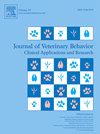An investigation of force potential against the companion dog neck associated with collar use
IF 1.3
3区 农林科学
Q4 BEHAVIORAL SCIENCES
Journal of Veterinary Behavior-clinical Applications and Research
Pub Date : 2024-10-30
DOI:10.1016/j.jveb.2024.10.007
引用次数: 0
Abstract
Pulling behavior while on-lead in dogs is a common problem with the potential for serious injury to both dogs and humans. Harnesses are often marketed as a “no pull” alternative to traditional neck collars. However, a literature search revealed only one previous study comparing leash tension in collars vs. harnesses worn by dogs lured with a food treat which showed greater leash tension when using a harness compared to collar. To further investigate this occurrence, our study compares pulling force generated by dogs of various sizes wearing either a traditional neck collar or chest harness when exposed to common environmental stimuli. Privately owned companion dogs (n = 28) were evaluated in a randomized cross-over design wearing a 1.5-inch flat nylon collar and standard padded chest harness clipped in the back and grouped as follows: small (≤ 13 kg); medium (14–22 kg); or large (≥ 23 kg). Each dog was presented with three commonly encountered environmental stimuli (unfamiliar dog, food, thrown toy) during a walk outdoors. Pulling force against the neck was measured with a digital dynamometer attached between the collar/harness and leash and measured as pound-force (lbf). Measurements were converted to Newtons (N) for statistical analysis (1 lbf = 4.45 N). Dogs pulled with greater mean force (P < 0.0001) while wearing a harness as compared to a collar (60.5 ± 3.91 N and 37.81 ± 3.51 N, respectively). Furthermore, peak pulling force was also greater in the back-clip harness (198.84 ± 5.43 N) as compared to the collar (162.80 ± 5.38 N) (P = 0.03). When peak pulling force was expressed as a % of body weight (% BW), dogs categorized as small pulled with the highest force (122 ± 9.45% BW) when compared to the medium and large group (85.8 ± 10.09% BW; 82.7 ± 3.62% BW) respectively (P < 0.0001). These data are the first to compare measured force exerted by dogs exhibiting natural pulling tendencies and demonstrate that companion dogs pulled with greater force when wearing a padded harness as compared to a traditional collar. This information may help provide insight into the selection of proper equipment for dogs to improve the walking experience for both dogs and their owners.
求助全文
约1分钟内获得全文
求助全文
来源期刊
CiteScore
3.50
自引率
16.70%
发文量
107
审稿时长
325 days
期刊介绍:
Journal of Veterinary Behavior: Clinical Applications and Research is an international journal that focuses on all aspects of veterinary behavioral medicine, with a particular emphasis on clinical applications and research. Articles cover such topics as basic research involving normal signaling or social behaviors, welfare and/or housing issues, molecular or quantitative genetics, and applied behavioral issues (eg, working dogs) that may have implications for clinical interest or assessment.
JVEB is the official journal of the Australian Veterinary Behaviour Interest Group, the British Veterinary Behaviour Association, Gesellschaft fr Tierverhaltensmedizin und Therapie, the International Working Dog Breeding Association, the Pet Professional Guild, the Association Veterinaire Suisse pour la Medecine Comportementale, and The American Veterinary Society of Animal Behavior.

 求助内容:
求助内容: 应助结果提醒方式:
应助结果提醒方式:


